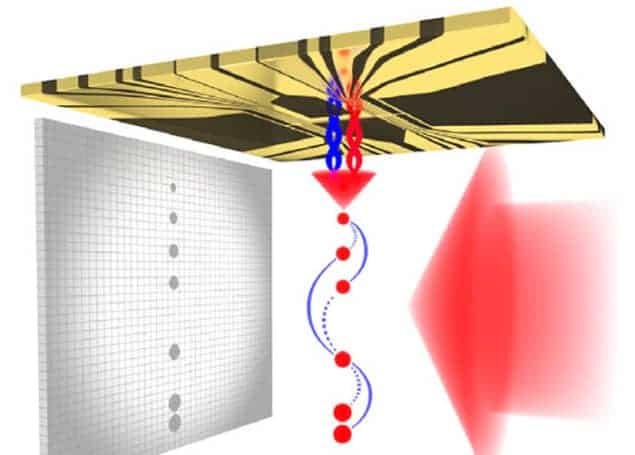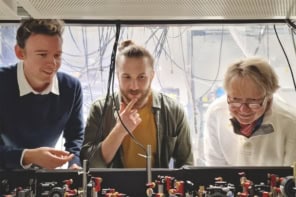
A new sensor that measures the local acceleration due to gravity using a Bose–Einstein condensate (BEC) of ultracold atoms has been made by physicists in Germany, the US and Canada. While the prototype device is not as accurate as commercial gravimeters, its makers say it could be made much smaller and much more accurate than existing devices.
Atoms can be used to measure the acceleration due to gravity by cooling a gas of them to near absolute zero and then dropping them along two different paths in an interferometer. The quantum interference that occurs when the paths converge at a detector provides a very good measure of gravity, with commercial atom interferometers able to measure the acceleration to within one part in 108. Such measurements are invaluable for geological exploration because the presence of certain minerals can be spotted by seeking tiny variations in gravity at the Earth’s surface.
While these ultracold atom gravimeters are on a par with conventional absolute gravimeters based on macroscopic falling masses, their accuracy could be improved a lot by using a BEC. In a conventional atomic gravimeter, the ultracold atoms form a diffuse gas roughly a millimetre in size and a major cause of uncertainty is that the laser pulses used to control the atoms are not spatially uniform on that length scale. A BEC – formed by cooling a gas of atoms with integer spin until they condense into a single quantum state – reduces this uncertainty because it squeezes the atoms into a region that is about 100 times smaller.
Tiny vacuum chamber
Created by Ernst Rasel of Leibniz University of Hannover and colleagues, the BEC gravimeter has at its heart a chip a few centimetres in size that contains a tiny vacuum chamber. Lasers and magnetic fields trap about 15,000 rubidium atoms at the top of the chip, where they are cooled to temperatures of a few nanokelvin to create a BEC.
The BEC is then allowed to fall about 1 cm through the chamber and, as it does so, a series of laser pulses is fired at the BEC, deflecting the atoms into different paths to create an interferometer. It takes about 10 ms for the atoms to complete their free fall, but the sensitivity can be improved if this time is extended using a laser pulse to bounce the atoms back up when they reach the bottom of the chip. The atoms are then allowed to fall back down again, increasing the free-fall time by a factor of five.
Rasel and colleagues were able to measure the acceleration of the atoms with an accuracy of about one part in 107 – at least an order of magnitude worse than commercial gravimeters. Writing in Physical Review Letters, the researchers point out that their gravimeter was operated in a “rough environment without access to any vibrational shielding”, which caused much of the measurement uncertainty. By reducing the vibrations and doing other improvements, Rasel and colleagues reckon the gravimeter could operate with an uncertainty of less than one part in 109 and fit inside of a backpack.



